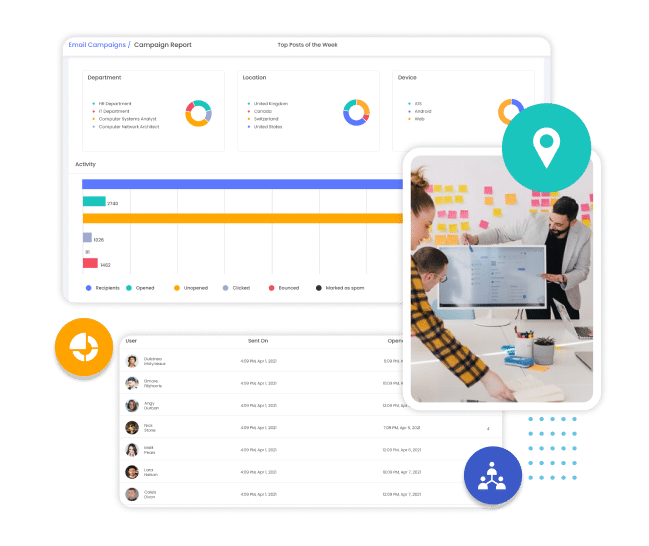In today’s business environment that is fast-paced, effective communication is the foundation of an effective business. To ensure productivity and employee participation, it’s vital that employees communicate effectively, whether they are working remotely, in-person, or using a hybrid model. This is why business communication software plays an essential role. Companies who invest in internal communications software not only help reduce workplace confusion but also build an environment of openness, collaboration, and inclusion.

Image credit: hubengage.com
If your company is using old email systems, unconnected chat software, or fragmented channels of communication, then it’s time to think about modern communication tools for internal use. They can help streamline conversations and bring employees together.
Business Needs Advanced Communication Tools
Bulletin boards and emails are no longer the primary ways of interacting with employees. Today, businesses live in a world that is characterized by instant communication, real-time collaboration and digital workplaces. Organisations that lack the appropriate tools for internal communication risk ineffective communication, lower engagement and lower productivity.
1. Inspiring employees to be more motivated
In today’s workplace, keeping employees engaged and motivated is a big challenge. A well-structured internal communications software ensures that all employees regardless of their location feel included and heard. Features like:
Real-time announcements.
Interactive feedback polls.
Employee Recognition Programs
Mobile-friendly communication platforms.
Helping businesses to create an atmosphere of belonging for their employees will lead to increased productivity and job satisfaction.
2. Reduce confusion at work and improve Clarity
When employees don’t receive clear communication, misunderstandings happen. This can result in missed deadlines and duplicate work. This can also lead to frustration. Business communication software can help:
Centralized information sharing Employees have access to information, documents, updates and resources in one location.
Tools for tracking projects and tasks. Everyone understands their role and what they’re required to perform.
Clearer workflows: Reduces bottlenecks, ensuring projects are handled efficiently.
Employers who work in organizations that have structured internal communication platforms are more efficient and confident.
3. Transparency & Culture within the Workplace
A solid corporate culture is based on trust and open communication. If employees feel that they are kept informed of corporate goals, changes and developments They are more likely to stay active and in line with the company’s mission.
Modern tools for internal communications offer options like:
Video messages from leaders – Direct communication by executives to employees.
Town halls and Q&A sessions to employees – promoting two-way communication.
Employee recognition and appreciation programs: Recognizing hard-working employees.
Businesses can create loyal employees by encouraging honest and open communication.
4. Supporting Remote & Hybrid Work Models
Traditional communication methods no longer work as companies are adopting remote or hybrid work. Teams require immediate access to conversations or meetings, as well as files, no matter which location they work from.
Cloud-based communications software allows for:
Seamless collaboration across different time zones.
Document sharing made easy, and co-editing in real time.
Virtual meetings can be held with video conferencing.
Mobile apps for communication.
Employers who use internal communications systems designed for remote teams experience more productivity and better collaboration when over those who rely on old-fashioned methods of communication.
5. Improving Crisis Management & Business Continuity
Emergencies can happen at any moment, whether it’s an attack on a computer, market disruption, or a reorganization of a company. A solid tool for communicating with business gives employees immediate updates, safety guidelines and other essential instructions during a time of situation of crisis.
Modern tools for internal communication provide:
You will receive instant notifications via push in the event of critical alerts being issued.
Automated message workflows to guide staff through difficult situations
Centralized knowledge base and emergency procedures
A well-planned and organized business can help minimize disruption, increase productivity, and ensure that employees are kept informed in the event of an unexpected incident.
The Future of Internal Communication Software
The expectations for the software used for business communication are changing as technology improves. AI-powered platforms for communication give companies advantage through automation of repetitive tasks as well as analysis of employee information and engagement, and personalised communication strategies.
A few trends that are emerging include:
AI chatbots that provide instant support for employees.
The use of sentiment analysis in order to determine the level of morale at work.
Interactive dashboards provide real-time communication analytics.
Utilizing intuitive, intelligent software to manage internal communications companies can build more cohesive teams, and improve their overall efficiency.
Last Thoughts: Selecting the Right Internal Communications Platform
Improve your internal communication system If your business is struggling with a lack of communication, disengaged employees or unconnected workflows. Business communication software can transform your workplace from one where people are disengaged and uncommunicative into one that’s focused on collaboration with transparency, engagement and teamwork.
Modern software for internal communications is not an option anymore. It’s an absolute necessity for companies that want to remain competitive, hold the best employees and foster an environment that promotes a positive work culture.
What are the top platforms for internal communication for your company? Start by searching for solutions that offer real-time messaging as well as mobile access. Also, think about centralizing sharing of data, engagement with the leadership team, and management involvement.
